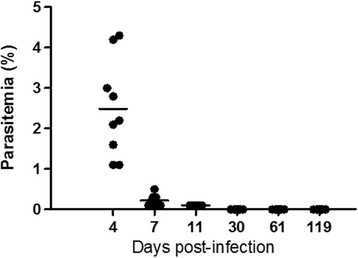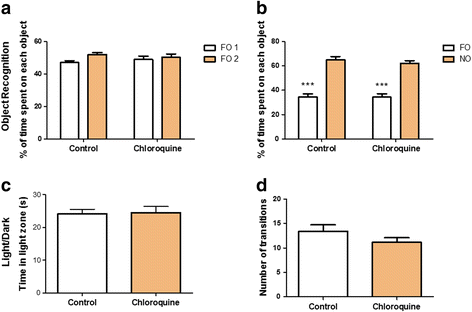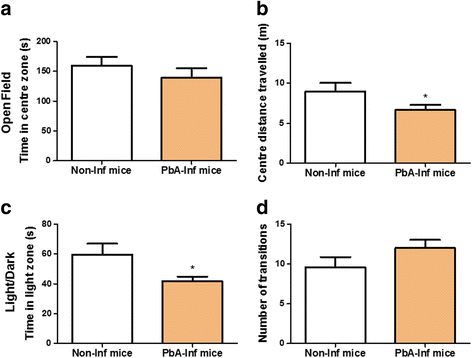Long-term effect of uncomplicated Plasmodium berghei ANKA malaria on memory and anxiety-like behaviour in C57BL/6 mice
- PMID: 29554958
- PMCID: PMC5859440
- DOI: 10.1186/s13071-018-2778-8
Long-term effect of uncomplicated Plasmodium berghei ANKA malaria on memory and anxiety-like behaviour in C57BL/6 mice
Abstract
Background: Cerebral malaria, the main complication of Plasmodium falciparum infection in humans, is associated with persistent neurocognitive sequels both in human disease and the murine experimental model. In recent years, cognitive deficits related to uncomplicated (non-cerebral) malaria have also been reported in chronically exposed residents of endemic areas, but not in some murine experimental models of non-cerebral malaria. This study aimed at evaluating the influence of uncomplicated malaria on different behavioural paradigms associated with memory and anxiety-like parameters in a murine model that has the ability to develop cerebral malaria.
Methods: Plasmodium berghei ANKA-infected and non-infected C57BL/6 mice were used. Development of cerebral malaria was prevented by chloroquine treatment starting on the fourth day of infection. The control group (non-infected mice) were treated with PBS. The effect of uncomplicated malaria infection on locomotor habituation, short and long-term memory and anxious-like behaviour was evaluated 64 days after parasite clearance in assays including open field, object recognition, Y-maze and light/dark tasks.
Results: Plasmodium berghei ANKA-infected mice showed significant long-lasting disturbances reflected by a long-term memory-related behaviour on open field and object recognition tasks, accompanied by an anxious-like phenotype availed on open field and light-dark tasks.
Conclusions: Long-term neurocognitive sequels may follow an uncomplicated malaria episode in an experimental model prone to develop cerebral malaria, even if the infection is treated before the appearance of clinical signs of cerebral impairment.
Keywords: Anxiety; Behavioural impairment; C57BL/6 mice; Memory; Plasmodium berghei; Uncomplicated malaria.
Conflict of interest statement
Ethics approval
The experiments were approved by the Ethics Committee on the Use of Laboratory Animals (CEUA-IOC: L-010/2015) and all procedures related to animal behaviour were performed in accordance with the NIH Guide for the Care and Use of Laboratory Animals.
Consent for publication
Not applicable.
Competing interests
The authors declare that they have no competing interests.
Publisher’s Note
Springer Nature remains neutral with regard to jurisdictional claims in published maps and institutional affiliations.
Figures





Similar articles
-
Cannabidiol increases survival and promotes rescue of cognitive function in a murine model of cerebral malaria.Neuroscience. 2015 Mar 19;289:166-80. doi: 10.1016/j.neuroscience.2014.12.051. Epub 2015 Jan 13. Neuroscience. 2015. PMID: 25595981
-
Cognitive dysfunction is sustained after rescue therapy in experimental cerebral malaria, and is reduced by additive antioxidant therapy.PLoS Pathog. 2010 Jun 24;6(6):e1000963. doi: 10.1371/journal.ppat.1000963. PLoS Pathog. 2010. PMID: 20585569 Free PMC article.
-
Lambda-carrageenan treatment exacerbates the severity of cerebral malaria caused by Plasmodium berghei ANKA in BALB/c mice.Malar J. 2014 Dec 11;13:487. doi: 10.1186/1475-2875-13-487. Malar J. 2014. PMID: 25495520 Free PMC article.
-
Changes in brain metabolites in experimental cerebral malaria infection with plasmodium berghei ANKA: a literature review.J Pak Med Assoc. 2014 Oct;64(10):1179-85. J Pak Med Assoc. 2014. PMID: 25823161 Review.
-
Genetic analysis of cerebral malaria in the mouse model infected with Plasmodium berghei.Mamm Genome. 2018 Aug;29(7-8):488-506. doi: 10.1007/s00335-018-9752-9. Epub 2018 Jun 19. Mamm Genome. 2018. PMID: 29922917 Review.
Cited by
-
Antidepressant-Like Effects of Chronic Guanosine in the Olfactory Bulbectomy Mouse Model.Front Psychiatry. 2021 Aug 4;12:701408. doi: 10.3389/fpsyt.2021.701408. eCollection 2021. Front Psychiatry. 2021. PMID: 34421682 Free PMC article.
-
Non-cerebral malaria: does such a thing exist?Mem Inst Oswaldo Cruz. 2025 Feb 3;120:e240223. doi: 10.1590/0074-02760240223. eCollection 2025. Mem Inst Oswaldo Cruz. 2025. PMID: 39907418 Free PMC article. Review.
-
Hyperbaric Oxygen Therapy Attenuated the Motor Coordination and Cognitive Impairment of Polyglutamine Spinocerebellar Ataxia SCA17 Mice.Cerebellum. 2024 Apr;23(2):401-417. doi: 10.1007/s12311-023-01548-y. Epub 2023 Mar 21. Cerebellum. 2024. PMID: 36943575
-
Increased Neutrophil Percentage and Neutrophil-T Cell Ratio Precedes Clinical Onset of Experimental Cerebral Malaria.Int J Mol Sci. 2023 Jul 12;24(14):11332. doi: 10.3390/ijms241411332. Int J Mol Sci. 2023. PMID: 37511092 Free PMC article.
-
Immune system challenge improves recognition memory and reverses malaria-induced cognitive impairment in mice.Sci Rep. 2021 Jul 21;11(1):14857. doi: 10.1038/s41598-021-94167-8. Sci Rep. 2021. PMID: 34290279 Free PMC article.
References
-
- Silva JR, Ramos Ade S, Machado M, de Moura DF, Neto Z, Canto-Cavalheiro MM, et al. A review of antimalarial plants used in traditional medicine in communities in Portuguese-speaking countries: Brazil, Mozambique, Cape Verde, Guinea-Bissau, São Tomé and Príncipe and Angola. Mem Inst Oswaldo Cruz. 2011;106:142–158. doi: 10.1590/S0074-02762011000900019. - DOI - PubMed
-
- World Health Organization . World Malaria Report. Geneva: WHO; 2016.
-
- Mung’Ala-Odera V, Snow RW, Newton CR. The burden of the neurocognitive impairment associated with Plasmodium falciparum malaria in sub-Saharan Africa. Am J Trop Med Hyg. 2004;71:64–70. - PubMed
Publication types
MeSH terms
Substances
LinkOut - more resources
Full Text Sources
Other Literature Sources
Medical

